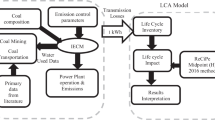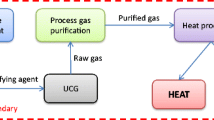Abstract
Purpose
The goal of this paper is to describe the life cycle inventory (LCI) approach to the cokemaking process in the Integrated Steel Plant’s Coke Oven Battery (ISPCOB) in Kraków, Poland. The system boundaries were labeled as gate-to-gate, covering the full chain process of coke production. The background input and output data from the coke production process (CPP) has been inventoried.
Methods
The functional unit (FU) was produced of 1 Mg of the coke in ISPCOB. The following inputs and outputs have been taken into account in the LCI study: product (coke), all intermediate products, by-products, and emissions. Raw fuel mining and means of external transportation of natural gas, manufacture of downstream products, their use, end of life, and infrastructure were not included. Time coverage is 2004, because since 2005, robust inventory data coverage of full ISP coke processes are lacking. Data used for inventory calculation are affected by uncertainty.
Results and discussion
With regard to 1 Mg of coke produced in ISPCOB in 2004, the consumption of coke coal and coke oven gas amounted to 1.35 Mg and 195 m3, respectively. The main materials, fuels, and energy used for the coke production were electric energy, steam, air, heat, and industrial water. Emissions of SO2, NO2, CO, CO2, NH3, aliphatic hydrocarbons, HCN, H2S, CS2, benzene, xylene, toluene, phenol, pyridine, dust, tar matters, Cr, Cd, Cu, Pb, Ni, and Mn have been considered.
Conclusions
The data for the LCI have been based on the year 2004. Uncertainty assessment in LCI is discussed. The purpose of this study is to help ISP authorities to solve environmental and technical aspects, as well as to train steel industry people in the field of life cycle assessment. Finally, presented LCI study for ISPCOB can serve as a representative data for LCA analysis of coke production in coke plants.
Recommendations
The impact assessment phase aims to present more understandable results from the inventory analysis, and life cycle impact assessment (LCIA) will be the direction for future research.


Similar content being viewed by others
References
Barella S, Bondi E, Di Cecca C, Ciuffini AF, Gruttadauria A, Mapelli C, Mombelli D (2014) New perspective in steelmaking activity to increase competitiveness and reduce environmental impact. La Metallurgia Italiana n.11-12:31–40
Bieda B (2011) Life cycle inventory of energy production in ArcelorMittal steel power plant Poland S.A. in Krakow, Poland. Int J Life Cycle Assess 16:503–511
Bieda B (2012a) Life cycle inventory processes of the ArcelorMittal Poland (AMP) S. A. in Kraków, Poland – basic oxygen furnace steel production: a case study. Int J Life Cycle Assess 17(4):463–470
Bieda B (2012b) Life cycle inventory processes of the Mittal Steel Poland (MSP) S. A. in Krakow – blast furnace pig iron production – a case study. Int J Life Cycle Assess 17(6):787–794
Bieda B, Tadeusiewicz R (2005) Optimal schemes of groundwater monitoring for prevention of contaminated water intrusion in the Ispat Polska Stal S.A. in Krakow, Poland. Water resources management III, third international conference on Water resources management, eds. M. de Conçeicao Cunha, C. A. Brebbia. Southampton, Boston, WIT Press, 2005 (WIT Transactions on Ecology and the Environment. Vol. 80:69–77
Burchart-Korol D (2013) Life cycle assessment of steel production in Poland: a case study. J Clean Prod 54:235–243
Clavreul J, Guyonnet D, Tonini D, Christensen TH (2013) Stochastic and epistemic uncertainty propagation in LCA. Int J Life Cycle Assess 18(7):1393–1403
Commission E (2009) Integrated pollution prevention and control. Draft reference document on best available techniques for the production of iron and steel. Institute for Prospective Technological Studies, Seville
DECC (2010) Coal trade and production statistics. Digest of UK energy statistics. Department of Energy and Climate Change, London
EC (2008) Guidance on the interpretation of key provisions of Directive 2008/98/EC on waste. http://ec.europa.eu/environment/waste/framework/pdf/guidance_doc.pdf. Accessed 10 Oct 2014
Finnveden G, Hauschild MZ, Ekvall T, Guinée J, Heijungs R, Hellweg S, Koehler A, Pennington D, Suh S (2009) Recent development in life cycle assessment. J Environ Manag 91(1):1–21
Hunkeler D, Rebitzer G (2005) Editorial: the future of life cycle assessment. Int J Life Cycle Assess 10(5):305–307
Iosif A-M, Hanrot F, Birat J-P, Ablitzer D (2010) Physicochemical modelling of classical steelmaking route for life cycle inventory analysis. Int J Life Cycle Assess 15:304–310
ISD DUNAFERR (2012) Absolute record at the coking plant http://www.dunaferr.hu/en/mediacentre/press-release/301-aaa. Accessed 13 July 2014
ISO 14040 (2006) Environmental management – life cycle assessment – principles and framework. International Organization for Standarization, Geneva
ISO 14041 (2006) Environmental management – life cycle assessment – goal and scope definition and inventory analysis. International Organization for Standarization, Geneva
ISO 14044 (2006) Environmental management – life cycle assessment – requirements and guidelines. International Organization for Standarization, Geneva
Jarno L (2005) Rola Jastrzębskiej Spółki Węglowej S.A. w tworzeniu Grupy Węglowo-Koksowej. POLITYKA ENERGETYCZNA 8(Zeszyt specjalny):613–621, Polish
Jones A (2013) Coke Markets-European perspective. Eurocoke Conference, Kraków, Poland. http://www.resource-net.com. Accessed 15 Oct 2014
Kim YM, Park D, Lee DS, Park JM (2007) Instability of biological nitrogen removal in a cokes wastewater treatment facility during summer. J Hazard Mater 141:27–32
Kim YM, Park D, Jeon CO, Lee DS, Park JM (2008) Effect of HRT on the biological pre-denitrifaction process for simultaneous removal of toxic pollutants from cokes wastewater. Bioresour Technol 99:8824–8832
Klejnowski K, Łusiak T, Morel J, Olczak C, Sobolewski A, Ściążko M, Tatara T (2005) The Best Available Techniques (BAT) Guidelines for the coking industry. The Ministry of Environment. Warszawa, December 2005. (Polish: NAJLEPSZE DOSTĘPNE TECHNIKI (BAT) WYTYCZNE DLA BRANŻY KOKSOWNICZEJ (2005) Ministerstwo Środowiska Warszawa, grudzień 2005)
Klüppel HJ (1998) ISO 14041: environmental management – life cycle assessment – goal and scope definition - inventory analysis. Int J Life Cycle Assess 3(6):301
Kosyrczyk L, Świeboda B, Lewandowski L (2012) Co nowego w chińskim koksownictwie (2012). KARBO 4:216–221
Kulczycka J, Henclik (2009) Ocena wpływu cyklu życia procesów wytwórczych na Wydziałach Surowcowych i Wytwarzania Stali Huty ArcelorMittal Poland SA, Oddział w Krakowie, Polish Akademy of Sciences, Krakow (in Polish)
Kulczycka J, Kurczewski P, Kasprzak J, Lewandowska A, Lewicki R, Witczak A, Witczak J (2011) The polish centre for life cycle assssment-the centre for life cycle assessment in Poland. Int J Life Cycle Assess 16:442–444
Kumar MS, Vaidya AN, Shivaraman N, Bal AS (2003) Performance evaluation of a full-scale coke oven waste water treatment plant in an integrated steel plant. Ind J Environ Health 45:29–38
Lindfors LG, Christiansen K, Hoffman L, Virtanen Y, Juntilla V, Hanssen OJ, Rønning A, Ekvall T, Finnvenden G (1995) Nordic guidelines on life-cycle assessment, Nird 1995: 20, Nordic Council of Ministers, Copenhagen Marañόn E, Vázquez I, Rodríguez J, Castrillόn L, Fernández Y, Lόpez H (2008) Treatment of coke wastewater in a sequential batch reactor (SBR) at pilot plant scale. Bioresour Technol 99:4192–4198
Liu X, Yuan Z (2015) Life cycle environment al performance of by-product coke production in China. J Clean Prod. doi:10.1016/j.jclepro.2014.12.102
Marañόn E, Vázquez I, Rodríguez J, Castrillόn L, Fernández Y, Lόpez H (2008) Treatment of coke wastewater in a sequential batch reactor (SBR) at pilot plant scale. Bioresour Technol 99:4192–4198
Mazur M, Gruszczyński S, Bergier T, Bogacki M, Grzesik K, Oleniacz R, Szczygłowski P, Wszołek T, Wszołek W, Ciesielka W, Litwa P, Kłaczyński M (2006) Wniosek o wydanie pozwolenia zintegrowanego dla Instalacji Mittal Steel Poland S.A. Oddział w Krakowie – Streszczenie (w języku niespecjalistycznym), Kraków, 2006 (in Polish)
McKenna RC, Norman JB (2010) Spatial modeling of industrial heat loads and recovery potentials in the UK. Energy Policy 38(10):5878–5891
Metallurgical Coal (Coke) (1997) http;//http://www.flatheadmemo.com/north_fork_coal/Coal/News/coke.html. Accessed 13 July 2014
Ministry of Industry and Information Technology of P.R. China (2010) Program of promoting the implementation of coke dry quenching technology in iron & steel industry nd coking industry
Mittal Steel Poland (2007) Environmental Impact Report (in Polish)
Nichol L (2012) Advancing cleaner coke production
Ochrona środowiska-ArcelorMittal Poland (2014) http:// http://poland.arcelormittal.com/odpowiedzialnosc-biznesu/zrownowazona-produkcja-stali/ochrona-srodowiska/czyste-i-ciche-instalacje.html. Accessed 31 March 2015
Ogłoszenie (2014) Ogłoszenie o udzieleniu przez Marszałka Województwa Małopolskiego pozwolenia zintegrowanego. http://bip.malopolska.pl/umwm/Article/get/id,972964.html. Accessed 31 March 2015
Ozga-Blaschke U, Lorenz U, Blaschke S, Okulski T (2008) In: Ozga-Blaschke U (ed) METODA OKREŚLENIA OPTYMALNEJ STRUKTURY KRAJOWEJ PRODUKCJI KOKSU NA PODSTAWIE BADAÑ RELACJI CEN STALI, KOKSU METALURGICZNEGO I WĘGLA KOKSOWEGO NA RYNKACH MIÊDZYNARODOWYCH, WYDAWNICTWO IGSMIE PAN, Kraków, 2008, https://www.min-pan.krakow.pl/se/ksiazki/metoda_koks_ozga2008_z.pdf. Accessed 20 Oct 2014 (in Polish)
Park D, Lee DS, Kim YM, Park JM (2007) Bioaugmentation of cyanide-degrading microorganisms in a full-scale Cowes wastewater treatment facility. Bioresour Technol 99:2092–2096
PE International (2010) GaBi 4.4 Software and databases, Leinfelden-echterdingen, Germany
Polenske KR, McMichael FC (2002) A Chinese cokemaking process-flow model for energy and environmental analyses. Energy Policy 30:865–883
Remus R. Monsonet MAA, Roudier S, Sancho D (2013) Best Available Techniques (BAT) reference document for iron and steel production. JRC reference report. Industrial Emissions Directive 2010/75/EU (Integated Pollution Prevention and Control). http://eippcb.jrc.ec.europa.eu/reference/BREF/IS_Adopted_03_2012.pdf. Accessed 25 March 2015
Sonnemann G. Castells F, Schumacher M (2004) Integrated life-cycle and risk assessment for industrial processes. Lewis Publishers. A CRC Press Company
Staib C, Lant P (2007) Thiocyanate degradation during activated sludge treatment of coke-ovens wastewater. Biochem Eng J 34:122–130
Udo de Haes HA, Heijungs R, Suh S, Huppes G (2004) Three strategies to overcome the limitations of life-cycle assessment. J Ind Ecol 8(3):19–32
Valia HS (2014) Coke production for blast furnace ironmaking. Steel Market Development Institute, Privacy Policy. http://www.autosteel.org/en/Steel_org/Web%20Root/Making%20Steel/How%20Its%20Made/Processes/Processes%20Info/Coke%20Production%20For%20Blast%20Furnace%20Ironmaking.aspx. Accessed 8 July 2014
Vasko FJ, Newhart DD, Strauss AD (2005) Coal blending models for optimum cokemaking and blast furnace operation. J Oper Res Soc 56:235–243
Walsh C, Thornley P (2012) The environmental impact and economic feasibility of introducing an Organic Rankine Cycle to recover low grade heat during the production of metallurgical coke. J Clean Prod 34:29–37
Warzecha A, Nocuń-Bąk M, Gałeczka G (2008) Polish coke making in light of international coke industry. SYMPOZJA I KONFERENCJE nr 73, Materiały XXII Konferencji z cyklu, Zagadnienia surowców energetycznych energii w gospodarce krajowe, Ustroñ, 19–22.10.2008. https://www.min-pan.krakow.pl/se/pelne_teksty22/czII/k22_warzecha_z.pdf. Accessed 8 Oct 2014 (in Polish)
Weidema B, Hischier R (2006) Ecoinvent data v2.2, St. Gallen, Switzerland
Więcław-Solny L, Krótki A, Tatarczuk A, Wilk A (2012) Zrozumieć process “Carbon Capturage” – badania procesu wychwytu CO2 ze spalin w Programie Strategicznym. Nowa Energia 2(26):183–184 (in Polish)
Woo SH, Jean CO, Yun Y-S, Choi H, Lee C-S, Lee DS (2009) On-line estimation of key process variables based on kernel partial least squares in an industrial cokes wastewater treatment plant. J Hazard Mater 161:538–544
World Steel Association (2011) Methodology report – life cycle inventory study for steel products, Brussels, Belgium
Xue B, Ma Z, Geng Y, Heck P, Ren W, Tobias M, Maas A, Jiang P, Puppim de Oliveira JA, Fujita T (2015) A life cycle co-benefits assessment of wind power in China. Renew Sust Energ Rev 41:338–346
Zhang M, Tay JH, Qian Y, Gu XS (1998) Coke plant wastewater treatment by fixed biofilm system for COD and HN3-N removal. Water Res 32:519–527
Zhou X, Li Y, Zhaob Y, Yueb X (2012) Pilot-scale anaerobic/anoxic/oxic/oxic biofilmprocess treating coking wastewater. Wiley Online Libr. doi:10.1002/jctb.3832
Acknowledgments
The authors would like to express their gratitude to the anonymous reviewers for their helpful comments.
Conflict of interest
The authors declare that they have no conflict of interest.
Compliance with ethical standards
Research is not involving human participants and/or animals.
Author information
Authors and Affiliations
Corresponding author
Additional information
Responsible editor: Zbigniew Stanislaw Klos
Rights and permissions
About this article
Cite this article
Bieda, B., Grzesik, K., Sala, D. et al. Life cycle inventory processes of the integrated steel plant (ISP) in Krakow, Poland—coke production, a case study. Int J Life Cycle Assess 20, 1089–1101 (2015). https://doi.org/10.1007/s11367-015-0904-9
Received:
Accepted:
Published:
Issue Date:
DOI: https://doi.org/10.1007/s11367-015-0904-9




